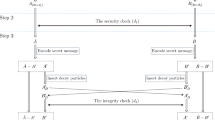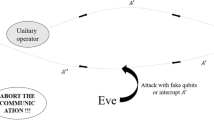Abstract
In the recent past, Mohapatra and Balakrishnan (Quantum Inf Process 16:147, 2017) proposed a controller-independent bidirectional quantum direct communication protocol using Bell states. In this work, we show the possibility of the achieving same protocol with non-maximally entangled states without compromising on the security and the efficiency of the protocol. We exploit the degree of entanglement as an additional security parameter. By doing so, the eavesdropper always gets detected in the initial stages of the protocol in the case of an intercept and resend attack. On the other hand, there is only 25% chance that the eavesdropper goes undetected in the initial stages of the protocol proposed by Mohapatra and Balakrishnan. Thus, the proposed protocol can be implemented with the viable physical resources.




Similar content being viewed by others
References
Bennet, C.H., Brassard, G.: Quantum cryptography: public key distribution and coin tossing. Theoret. Comput. Sci. 560, 7–11 (2014)
Beige, A., Englert, B.G., Kurtsiefer, C., Weinfurter, H.: Secure communication with a publicly known key. Acta Phys. Pol. A 101, 357 (2002)
Boström, K., Felbinger, T.: Deterministic secure direct communication using entanglement. Phys. Rev. Lett. 89, 187902 (2002)
Deng, F.G., Long, G.L., Xiao, S.L.: A two-step quantum direct communication protocol using Einstein–Podolsky–Rosen pair block. Phys. Rev. A 68, 042317 (2003)
Yan, F.L., Zhang, X.Q.: A scheme for secure direct communication using EPR pairs and teleportation. Eur. Phys. J. B 41, 75–78 (2004)
Deng, F.G., Long, G.L.: Secure direct communication with a quantum one-time pad. Phys. Rev. A 69, 052319 (2004)
Wang, C., Deng, F.G., Long, G.L.: Multi-step quantum secure direct communication using multi-particle Green–Horne–Zeilinger state. Opt. Commun. 253, 15–20 (2005)
Zhang, Z.J.: Multiparty quantum secret sharing of secure direct communication. Phys. Rev. A 342, 60–66 (2005)
Ruoyang, Q., Zhen, S., Lin, Z., Penghao, N., Wentao, H., Liyuan, S., Qin, H., Jiancun, G., Liuguo, Y., Gui, L.: Implementation and security analysis of practical quantum secure direct communication. Light Sci. Appl. 8, Article Number 22 (2019)
Zhang, W., et al.: Quantum secure direct communication with quantum memory. Phys. Rev. Lett. 118, 220501 (2017)
Srinatha, N., et al.: The quantum cryptographic switch. Quantum Inf. Process. 13, 59–70 (2014)
Nguyen, B.A.: Quantum dialogue. Phys. Lett. A 328, 6–10 (2004)
Zhong-Xiao, M., Zhan-Jun, Z., Li, Y.: Quantum dialogue revisited. Chin. Phys. Lett. 22, 22–24 (2005)
Chen, Y., Zhong-Xiao, M., Yun-Jie, X.: Quantum bidirectional secure direct communication via entanglement swapping. Chin. Phys. Lett. 24, 19–22 (2007)
Zhang, Z.J.: Deterministic secure direct bidirectional communication protocol. arxiv:quant-ph/0403186 (2004)
Yang, Y., Wen, Q.: Quasi-secure quantum dialogue using single photons. Sci. China Ser. G 50, 558–562 (2007)
Zhong-Xiao, M., Yun-Jie, X.: Controlled bidirectional quantum direct communication by using a GHZ state. Chin. Phys. Lett. 23, 1680–1682 (2006)
Tian-Yu, Y., Li-Zhen, J.: Improvement of controlled bidirectional quantum direct communication using a GHZ state. Chin. Phys. Lett. 30, 040305 (2013)
Zhi-Hao, L., Han-Wu, C.: Comment on improvement of controlled bidirectional quantum direct communication using a GHZ state. Chin. Phys. Lett. 30, 079901 (2013)
Tian-Yu, Y., Li-Zhen, J.: Reply to the comment on improvement of controlled bidirectional quantum direct communication using a GHZ state. Chin. Phys. Lett. 30, 079901 (2013)
Chang, C.H., Luo, Y.P., Yang, C.W., Tzonelih, H.: Intercept-and-resend attack on controlled bidirectional quantum direct communication and its improvement. Quantum Inf. Process. 14, 3515–3522 (2015)
Mohapatra, A.K., Balakrishnan, S.: Controller-independent bidirectional quantum direct communication. Quantum Inf. Process. 16, 147 (2017)
Nielsen, M.A., Chuang, I.L.: Quantum computation and quantum information: 10th anniversary edition. Chin. Phys. Lett. 30, 079901 (2011)
Cabello, A.: Quantum key distribution in the Holevo limit. Phys. Rev. Lett. 85, 5635–5638 (2000)
Author information
Authors and Affiliations
Corresponding author
Additional information
Publisher's Note
Springer Nature remains neutral with regard to jurisdictional claims in published maps and institutional affiliations.
Rights and permissions
About this article
Cite this article
Srikanth, A., Balakrishnan, S. Controller-independent quantum bidirectional communication using non-maximally entangled states. Quantum Inf Process 19, 133 (2020). https://doi.org/10.1007/s11128-020-02628-2
Received:
Accepted:
Published:
DOI: https://doi.org/10.1007/s11128-020-02628-2




